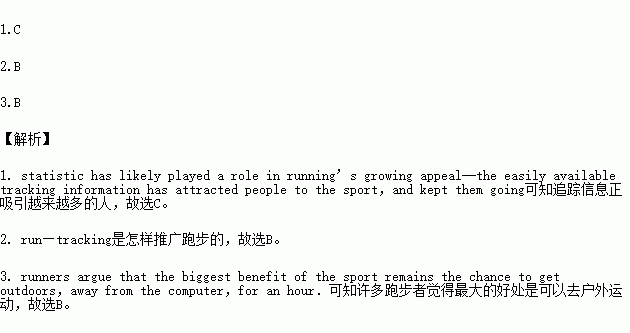ÌâÄ¿ÄÚÈÝ
Anybody who¡¯s noticed so many sweaty Sunday-morning photos on the Internet must think that marathons have recently regained popularity£®According to Running USA£¬an organization that tracks the sport¡¯s growth£¬52 percent of runners today track themselves with some sort of GPS-enabled device£¬like a smart phone or a fitness tracker£®This statistic has likely played a role in running¡¯s growing appeal--the easily available tracking information has attracted people to the sport£¬and kept them going£¬for it¡¯s possible for anyone to see in real time how it¡¯s affecting their bodias.
Today£¬free smart phone apps can give runners information on things like the number and length of their steps£¬their heart rate£¬even the estimated volume of oxygen they consume per minute£®All this information can act as a reward and a motivator for the runner£®¡°It¡¯s one thing to hear encouragement from a coach£®¡±Bryan Boyle£¬editor of Runner¡¯s World magazine£¬explains£®¡°It¡¯s quite another£¬however£¬to appreciate-at a glance-progress made during weeks and months of running£®¡¯¡¯
But run¡ªtracking technology doesn¡¯t just help runners train harder. It also gives them the power to train more intelligently£®Recreational runners today no longer have to guess how far or how fast they¡¯ve run£¬or what their body is doing£®If they can monitor their heart rate£¬they can make sure they¡¯re hitting the most strategic pace on each run£¬which can significantly increase their chances of having a positive experience on the course during race day£®
No matter how much technology can promote the experience of running£¬though£¬many runners argue that the biggest benefit of the sport remains the chance to get outdoors£¬away from the computer£¬for an hour£®¡°There¡¯s so much more to experience£¬¡± adds Boyle£®¡°fresh air£¬travel£¬shoot£¬just overall feeling better£®There¡¯s no app for that£®¡±
1.We can infer from the first paragraph that £®
A£®people enjoy posting sports pictures on the Internet
B£®Running USA plays a key role in the growth of running
C£®tracking technology is drawing more people on the road
D£®run¡ªtracking devices help people run faster than before
2.Which of the following questions are the second and third paragraphs intended to answer?
A£®What information can run¡ªtracking devices provide for the runners?
B£®How is the run¡ªtracking technology popularizing running?
C£®In what way is run¡ªtracking technology developed?
D£®Why do people have to rely on wearable devices in modern society?
3.As for the experienced runners£¬what attracts them most is £®
A£®the exciting experience technology brings them
B£®a chance to enjoy nature outdoors
C£®becoming popular on social media
D£®being cool with a new wearable device on the road
 Öп¼½â¶Á¿¼µã¾«Á·ÏµÁдð°¸
Öп¼½â¶Á¿¼µã¾«Á·ÏµÁдð°¸Kids Wall Art
Large wall posters for kids. Your kids will love these cool posters by artist Carla Daly. Your kids will enjoy decorating their bedroom walls with these posters and their friends will think they are the coolest!
Name: ABC Wall Art Size: 44¡Á72cm (17.5¡å¡Á28¡å) Time: 9:00 am every day Prices: $ 6.8/piece Colorful ABC art for your kids¡¯ bedroom and playroom. A fun, educational art piece that all kids will enjoy. Kids and babies will love learning their animals and the ABC at the same time! |
Name: Kids World Map Size: 45¡Á75cm (17.5¡å¡Á29.5¡å) Time: 2:00 pm on Wednesday Prices: $ 7.2/piece A colorful, large print by artist Carla Daly. Your kids will love this world map showing the lands, oceans and the fun animals that live in them. An educational ma |
Name: Skateboard Park Size: 44¡Á60cm (17.5¡å¡Á23.5¡å) Time: 9:00 am on weekends Prices: $ 8.8/piece Fun zebra children¡¯s wall art! Children and kids will love these fun animals enjoying this popular kids¡¯ sport. Boys and girls will enjoy decorating their bedroom walls with this colorful bedroom wall art. |
Name: City Slickers(³ÇÊÐÀÐ) Size: 44¡Á55cm(17.5¡å¡Á23.5¡å) Time: 2:00 pm every day except Friday Prices: $ 6.5/piece Cute kids wall art of two cool giraffes taking a drive through the city, unusual, fun style for kids¡¯ walls! Your kids will love this fun giraffe wall art. Boys and girls will have fun decorating their bedroom walls with this colorful bedroom wall art. |
1.Jane , who would like to buy a poster with the size of 45¡Á75cm, will probably buy ________.
, who would like to buy a poster with the size of 45¡Á75cm, will probably buy ________.
A. ABC Wall Art B. Kids World Map
C. Skateboard Park D. City Slickers
2.David plans to buy two posters. He should at least take ________ with him.
A. $ 15.3. B. $ 14. C. $ 12. D. $ 13.3.
3.Which of the following is TRUE according to the passage?
A. Kids can find two cool giraffes on Skateboard Park.
B. Kids can just learn some English letters on ABC Wall Art.
C. Kids can enjoy fun zebra children¡¯s wall art on City Slickers.
D. Kids can get some geography knowledge on Kids World Map.


 the evidence is suspe
the evidence is suspe ct. As Nick learns more about Gatsby, every detail about him seems questionable, except his love for the Daisy. Though Daisy is married, Gatsby still adores her as his ¨Dgolden girl.They first met when she was a young lady from a wealthy family and he was a working-class military officer. Daisy promised to wait for his return from the war. However, she married Tom, a classmate of Nick¡¯s. Having obtained a great fortune, Gatsby sets out to win her back again.
ct. As Nick learns more about Gatsby, every detail about him seems questionable, except his love for the Daisy. Though Daisy is married, Gatsby still adores her as his ¨Dgolden girl.They first met when she was a young lady from a wealthy family and he was a working-class military officer. Daisy promised to wait for his return from the war. However, she married Tom, a classmate of Nick¡¯s. Having obtained a great fortune, Gatsby sets out to win her back again. sby?
sby?